Comparative Analysis of Assessment Methods in Sri Lanka and the UK
VerifiedAdded on 2023/01/03
|13
|3160
|94
Report
AI Summary
This report provides a detailed comparative analysis of assessment methods employed in Sri Lanka and the United Kingdom. It begins with an introduction to assessment methodologies, differentiating between direct and indirect methods, and explores the objectives of assessment. The report then delves into the educational landscape of Sri Lanka, detailing the background of its educational curriculum, with a specific focus on School-Based Assessment (SBA). A similar in-depth analysis is provided for the United Kingdom, examining assessment practices across England, Scotland, Wales, and Northern Ireland. The report further discusses the impacts of these assessment methods and concludes with a comparative analysis, highlighting the similarities and differences between the two countries' approaches to evaluating student learning and the overall educational systems. The report explores the evolution of assessment methods, including formative, summative, confirmative, non-referenced, and criterion-referenced assessments, while also considering the influence of environmental factors on education in Sri Lanka.
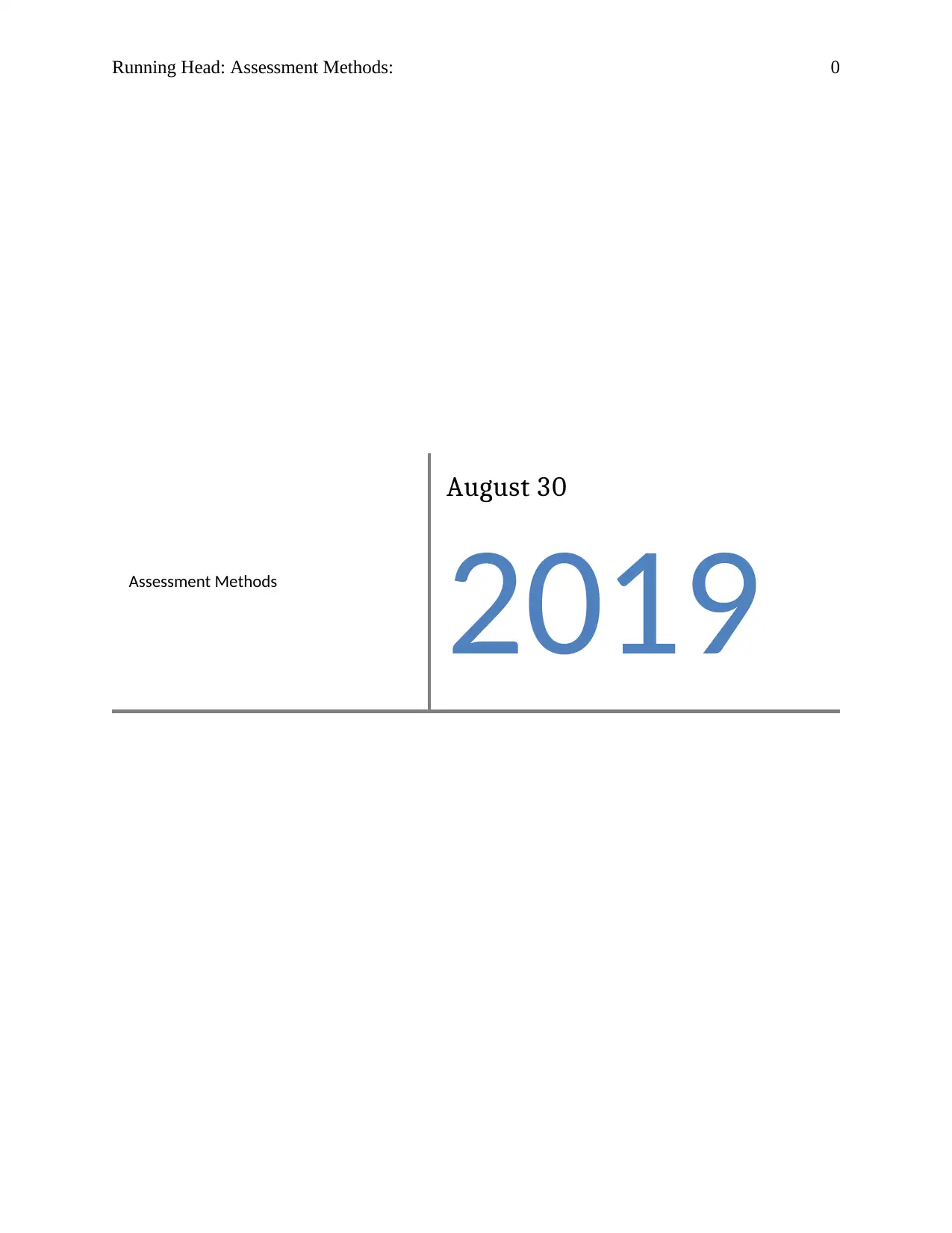
Running Head: Assessment Methods: 0
Assessment Methods
August 30
2019
Assessment Methods
August 30
2019
Paraphrase This Document
Need a fresh take? Get an instant paraphrase of this document with our AI Paraphraser
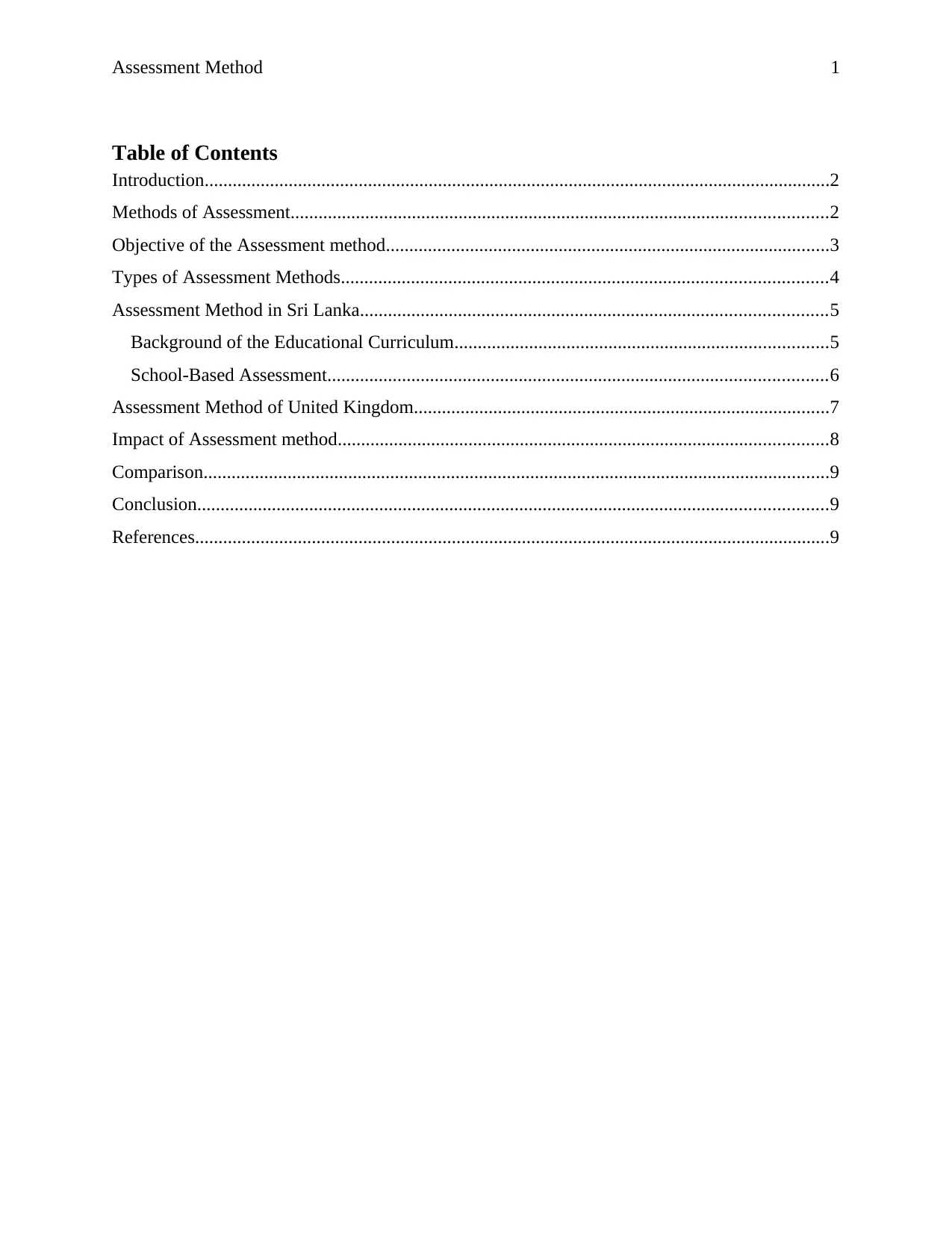
Assessment Method 1
Table of Contents
Introduction......................................................................................................................................2
Methods of Assessment...................................................................................................................2
Objective of the Assessment method...............................................................................................3
Types of Assessment Methods........................................................................................................4
Assessment Method in Sri Lanka....................................................................................................5
Background of the Educational Curriculum................................................................................5
School-Based Assessment...........................................................................................................6
Assessment Method of United Kingdom.........................................................................................7
Impact of Assessment method.........................................................................................................8
Comparison......................................................................................................................................9
Conclusion.......................................................................................................................................9
References........................................................................................................................................9
Table of Contents
Introduction......................................................................................................................................2
Methods of Assessment...................................................................................................................2
Objective of the Assessment method...............................................................................................3
Types of Assessment Methods........................................................................................................4
Assessment Method in Sri Lanka....................................................................................................5
Background of the Educational Curriculum................................................................................5
School-Based Assessment...........................................................................................................6
Assessment Method of United Kingdom.........................................................................................7
Impact of Assessment method.........................................................................................................8
Comparison......................................................................................................................................9
Conclusion.......................................................................................................................................9
References........................................................................................................................................9
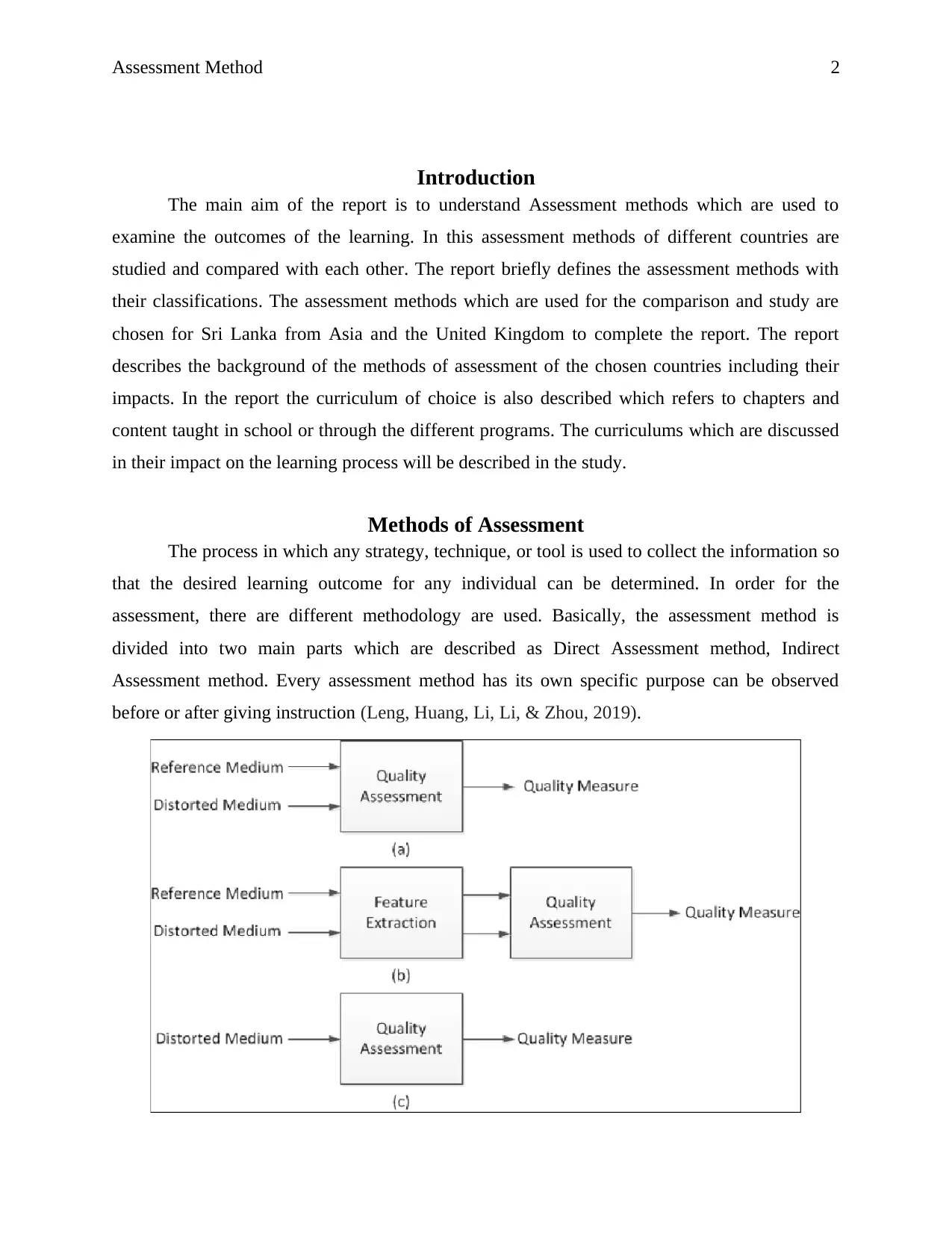
Assessment Method 2
Introduction
The main aim of the report is to understand Assessment methods which are used to
examine the outcomes of the learning. In this assessment methods of different countries are
studied and compared with each other. The report briefly defines the assessment methods with
their classifications. The assessment methods which are used for the comparison and study are
chosen for Sri Lanka from Asia and the United Kingdom to complete the report. The report
describes the background of the methods of assessment of the chosen countries including their
impacts. In the report the curriculum of choice is also described which refers to chapters and
content taught in school or through the different programs. The curriculums which are discussed
in their impact on the learning process will be described in the study.
Methods of Assessment
The process in which any strategy, technique, or tool is used to collect the information so
that the desired learning outcome for any individual can be determined. In order for the
assessment, there are different methodology are used. Basically, the assessment method is
divided into two main parts which are described as Direct Assessment method, Indirect
Assessment method. Every assessment method has its own specific purpose can be observed
before or after giving instruction (Leng, Huang, Li, Li, & Zhou, 2019).
Introduction
The main aim of the report is to understand Assessment methods which are used to
examine the outcomes of the learning. In this assessment methods of different countries are
studied and compared with each other. The report briefly defines the assessment methods with
their classifications. The assessment methods which are used for the comparison and study are
chosen for Sri Lanka from Asia and the United Kingdom to complete the report. The report
describes the background of the methods of assessment of the chosen countries including their
impacts. In the report the curriculum of choice is also described which refers to chapters and
content taught in school or through the different programs. The curriculums which are discussed
in their impact on the learning process will be described in the study.
Methods of Assessment
The process in which any strategy, technique, or tool is used to collect the information so
that the desired learning outcome for any individual can be determined. In order for the
assessment, there are different methodology are used. Basically, the assessment method is
divided into two main parts which are described as Direct Assessment method, Indirect
Assessment method. Every assessment method has its own specific purpose can be observed
before or after giving instruction (Leng, Huang, Li, Li, & Zhou, 2019).
⊘ This is a preview!⊘
Do you want full access?
Subscribe today to unlock all pages.

Trusted by 1+ million students worldwide
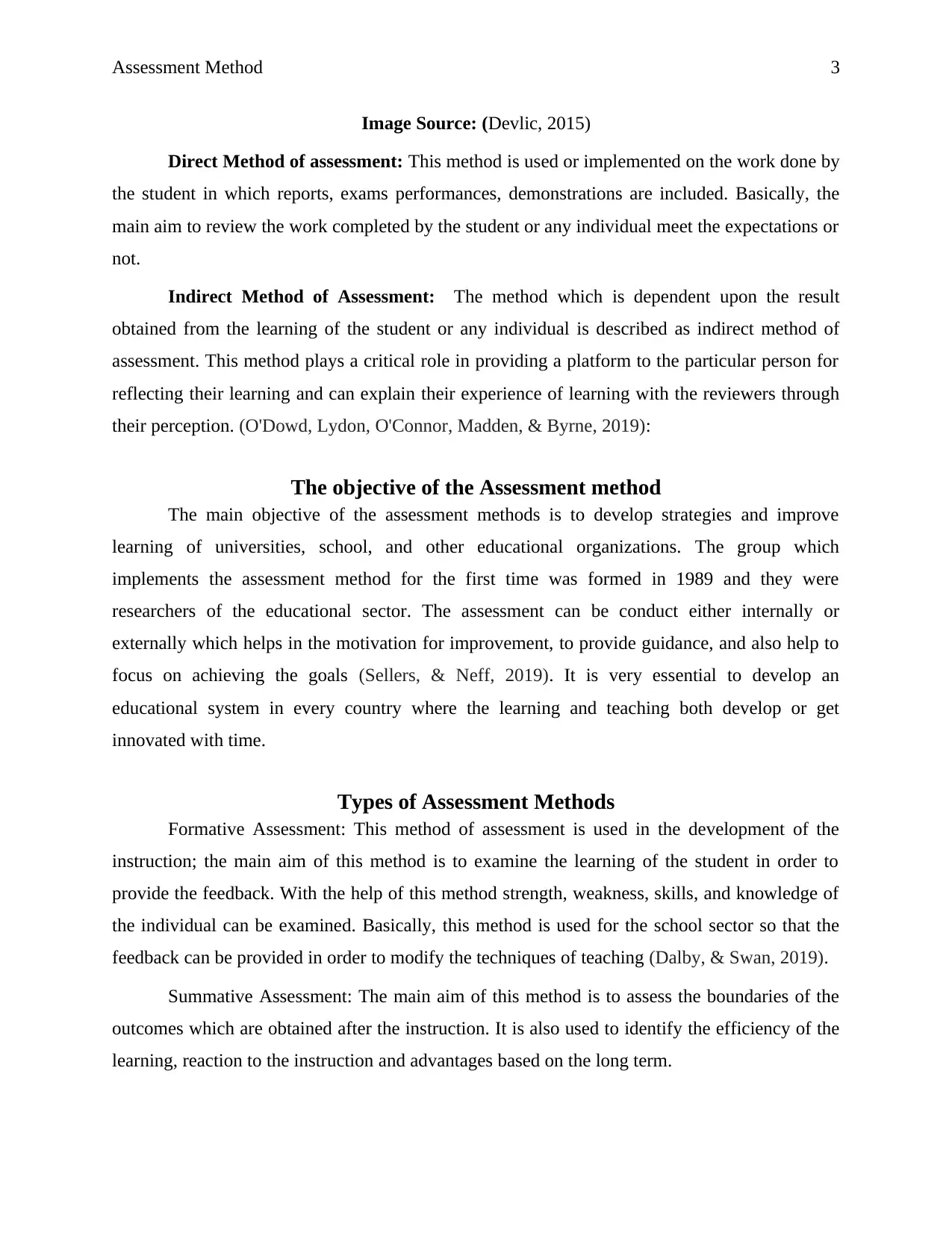
Assessment Method 3
Image Source: (Devlic, 2015)
Direct Method of assessment: This method is used or implemented on the work done by
the student in which reports, exams performances, demonstrations are included. Basically, the
main aim to review the work completed by the student or any individual meet the expectations or
not.
Indirect Method of Assessment: The method which is dependent upon the result
obtained from the learning of the student or any individual is described as indirect method of
assessment. This method plays a critical role in providing a platform to the particular person for
reflecting their learning and can explain their experience of learning with the reviewers through
their perception. (O'Dowd, Lydon, O'Connor, Madden, & Byrne, 2019):
The objective of the Assessment method
The main objective of the assessment methods is to develop strategies and improve
learning of universities, school, and other educational organizations. The group which
implements the assessment method for the first time was formed in 1989 and they were
researchers of the educational sector. The assessment can be conduct either internally or
externally which helps in the motivation for improvement, to provide guidance, and also help to
focus on achieving the goals (Sellers, & Neff, 2019). It is very essential to develop an
educational system in every country where the learning and teaching both develop or get
innovated with time.
Types of Assessment Methods
Formative Assessment: This method of assessment is used in the development of the
instruction; the main aim of this method is to examine the learning of the student in order to
provide the feedback. With the help of this method strength, weakness, skills, and knowledge of
the individual can be examined. Basically, this method is used for the school sector so that the
feedback can be provided in order to modify the techniques of teaching (Dalby, & Swan, 2019).
Summative Assessment: The main aim of this method is to assess the boundaries of the
outcomes which are obtained after the instruction. It is also used to identify the efficiency of the
learning, reaction to the instruction and advantages based on the long term.
Image Source: (Devlic, 2015)
Direct Method of assessment: This method is used or implemented on the work done by
the student in which reports, exams performances, demonstrations are included. Basically, the
main aim to review the work completed by the student or any individual meet the expectations or
not.
Indirect Method of Assessment: The method which is dependent upon the result
obtained from the learning of the student or any individual is described as indirect method of
assessment. This method plays a critical role in providing a platform to the particular person for
reflecting their learning and can explain their experience of learning with the reviewers through
their perception. (O'Dowd, Lydon, O'Connor, Madden, & Byrne, 2019):
The objective of the Assessment method
The main objective of the assessment methods is to develop strategies and improve
learning of universities, school, and other educational organizations. The group which
implements the assessment method for the first time was formed in 1989 and they were
researchers of the educational sector. The assessment can be conduct either internally or
externally which helps in the motivation for improvement, to provide guidance, and also help to
focus on achieving the goals (Sellers, & Neff, 2019). It is very essential to develop an
educational system in every country where the learning and teaching both develop or get
innovated with time.
Types of Assessment Methods
Formative Assessment: This method of assessment is used in the development of the
instruction; the main aim of this method is to examine the learning of the student in order to
provide the feedback. With the help of this method strength, weakness, skills, and knowledge of
the individual can be examined. Basically, this method is used for the school sector so that the
feedback can be provided in order to modify the techniques of teaching (Dalby, & Swan, 2019).
Summative Assessment: The main aim of this method is to assess the boundaries of the
outcomes which are obtained after the instruction. It is also used to identify the efficiency of the
learning, reaction to the instruction and advantages based on the long term.
Paraphrase This Document
Need a fresh take? Get an instant paraphrase of this document with our AI Paraphraser
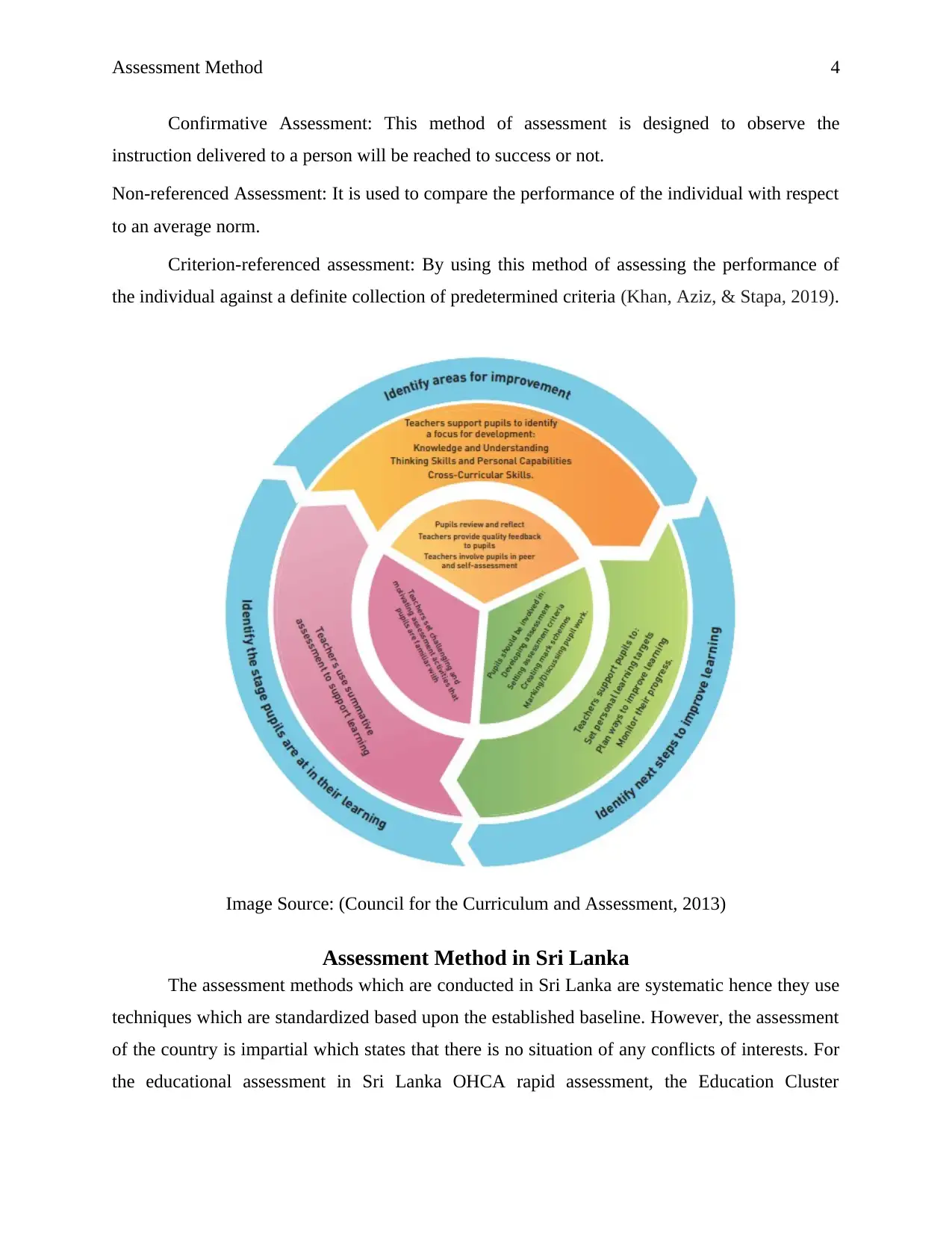
Assessment Method 4
Confirmative Assessment: This method of assessment is designed to observe the
instruction delivered to a person will be reached to success or not.
Non-referenced Assessment: It is used to compare the performance of the individual with respect
to an average norm.
Criterion-referenced assessment: By using this method of assessing the performance of
the individual against a definite collection of predetermined criteria (Khan, Aziz, & Stapa, 2019).
Image Source: (Council for the Curriculum and Assessment, 2013)
Assessment Method in Sri Lanka
The assessment methods which are conducted in Sri Lanka are systematic hence they use
techniques which are standardized based upon the established baseline. However, the assessment
of the country is impartial which states that there is no situation of any conflicts of interests. For
the educational assessment in Sri Lanka OHCA rapid assessment, the Education Cluster
Confirmative Assessment: This method of assessment is designed to observe the
instruction delivered to a person will be reached to success or not.
Non-referenced Assessment: It is used to compare the performance of the individual with respect
to an average norm.
Criterion-referenced assessment: By using this method of assessing the performance of
the individual against a definite collection of predetermined criteria (Khan, Aziz, & Stapa, 2019).
Image Source: (Council for the Curriculum and Assessment, 2013)
Assessment Method in Sri Lanka
The assessment methods which are conducted in Sri Lanka are systematic hence they use
techniques which are standardized based upon the established baseline. However, the assessment
of the country is impartial which states that there is no situation of any conflicts of interests. For
the educational assessment in Sri Lanka OHCA rapid assessment, the Education Cluster
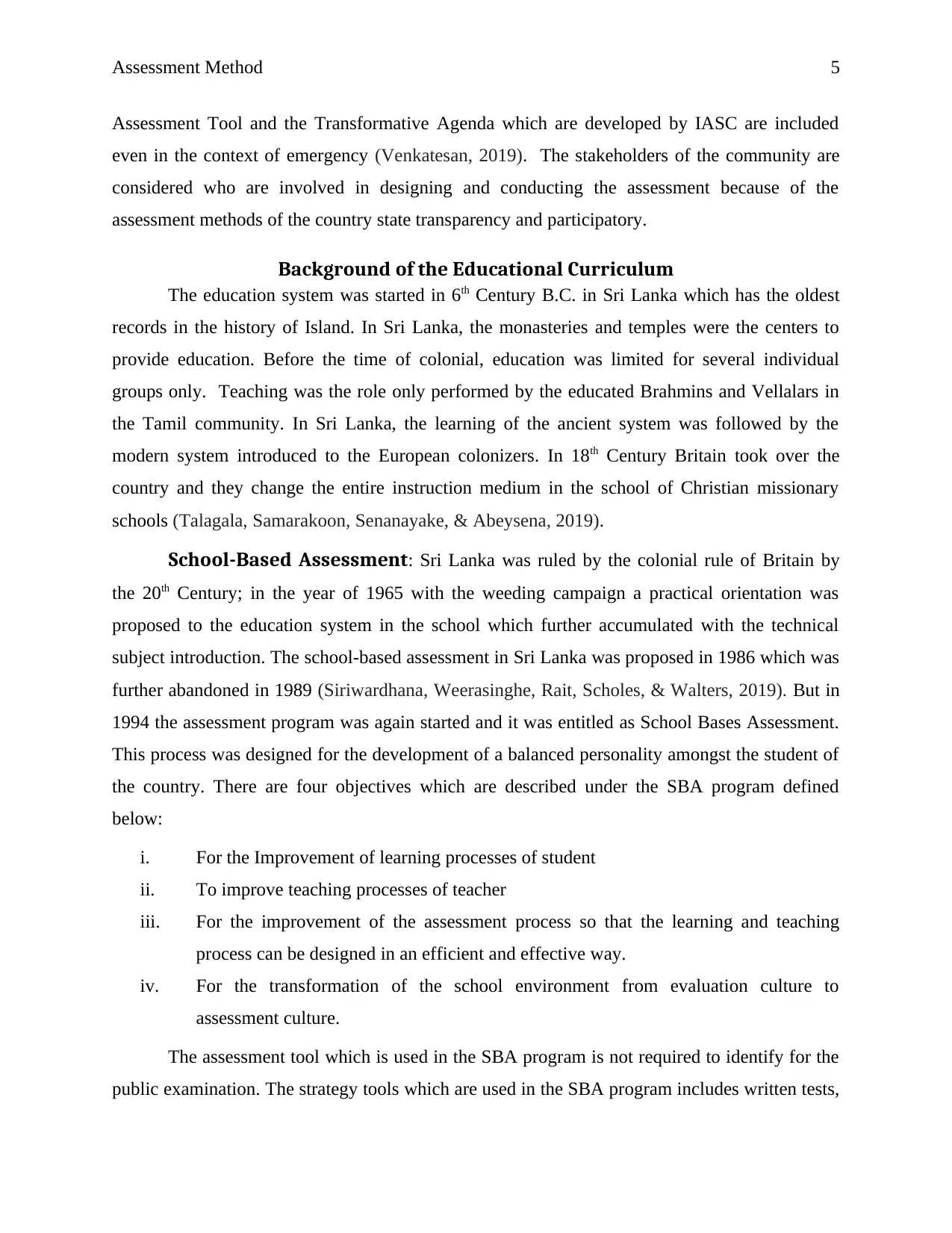
Assessment Method 5
Assessment Tool and the Transformative Agenda which are developed by IASC are included
even in the context of emergency (Venkatesan, 2019). The stakeholders of the community are
considered who are involved in designing and conducting the assessment because of the
assessment methods of the country state transparency and participatory.
Background of the Educational Curriculum
The education system was started in 6th Century B.C. in Sri Lanka which has the oldest
records in the history of Island. In Sri Lanka, the monasteries and temples were the centers to
provide education. Before the time of colonial, education was limited for several individual
groups only. Teaching was the role only performed by the educated Brahmins and Vellalars in
the Tamil community. In Sri Lanka, the learning of the ancient system was followed by the
modern system introduced to the European colonizers. In 18th Century Britain took over the
country and they change the entire instruction medium in the school of Christian missionary
schools (Talagala, Samarakoon, Senanayake, & Abeysena, 2019).
School-Based Assessment: Sri Lanka was ruled by the colonial rule of Britain by
the 20th Century; in the year of 1965 with the weeding campaign a practical orientation was
proposed to the education system in the school which further accumulated with the technical
subject introduction. The school-based assessment in Sri Lanka was proposed in 1986 which was
further abandoned in 1989 (Siriwardhana, Weerasinghe, Rait, Scholes, & Walters, 2019). But in
1994 the assessment program was again started and it was entitled as School Bases Assessment.
This process was designed for the development of a balanced personality amongst the student of
the country. There are four objectives which are described under the SBA program defined
below:
i. For the Improvement of learning processes of student
ii. To improve teaching processes of teacher
iii. For the improvement of the assessment process so that the learning and teaching
process can be designed in an efficient and effective way.
iv. For the transformation of the school environment from evaluation culture to
assessment culture.
The assessment tool which is used in the SBA program is not required to identify for the
public examination. The strategy tools which are used in the SBA program includes written tests,
Assessment Tool and the Transformative Agenda which are developed by IASC are included
even in the context of emergency (Venkatesan, 2019). The stakeholders of the community are
considered who are involved in designing and conducting the assessment because of the
assessment methods of the country state transparency and participatory.
Background of the Educational Curriculum
The education system was started in 6th Century B.C. in Sri Lanka which has the oldest
records in the history of Island. In Sri Lanka, the monasteries and temples were the centers to
provide education. Before the time of colonial, education was limited for several individual
groups only. Teaching was the role only performed by the educated Brahmins and Vellalars in
the Tamil community. In Sri Lanka, the learning of the ancient system was followed by the
modern system introduced to the European colonizers. In 18th Century Britain took over the
country and they change the entire instruction medium in the school of Christian missionary
schools (Talagala, Samarakoon, Senanayake, & Abeysena, 2019).
School-Based Assessment: Sri Lanka was ruled by the colonial rule of Britain by
the 20th Century; in the year of 1965 with the weeding campaign a practical orientation was
proposed to the education system in the school which further accumulated with the technical
subject introduction. The school-based assessment in Sri Lanka was proposed in 1986 which was
further abandoned in 1989 (Siriwardhana, Weerasinghe, Rait, Scholes, & Walters, 2019). But in
1994 the assessment program was again started and it was entitled as School Bases Assessment.
This process was designed for the development of a balanced personality amongst the student of
the country. There are four objectives which are described under the SBA program defined
below:
i. For the Improvement of learning processes of student
ii. To improve teaching processes of teacher
iii. For the improvement of the assessment process so that the learning and teaching
process can be designed in an efficient and effective way.
iv. For the transformation of the school environment from evaluation culture to
assessment culture.
The assessment tool which is used in the SBA program is not required to identify for the
public examination. The strategy tools which are used in the SBA program includes written tests,
⊘ This is a preview!⊘
Do you want full access?
Subscribe today to unlock all pages.

Trusted by 1+ million students worldwide
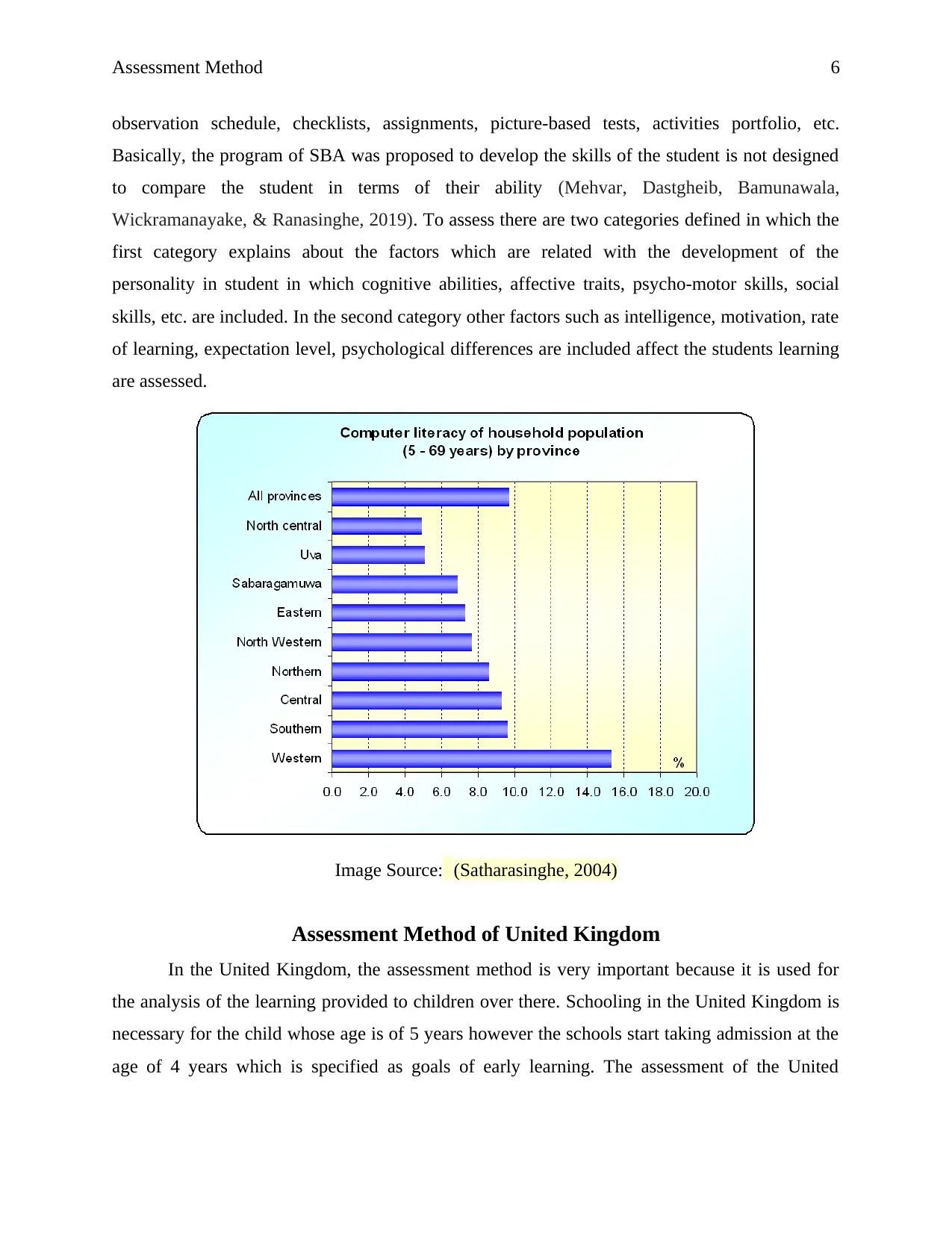
Assessment Method 6
observation schedule, checklists, assignments, picture-based tests, activities portfolio, etc.
Basically, the program of SBA was proposed to develop the skills of the student is not designed
to compare the student in terms of their ability (Mehvar, Dastgheib, Bamunawala,
Wickramanayake, & Ranasinghe, 2019). To assess there are two categories defined in which the
first category explains about the factors which are related with the development of the
personality in student in which cognitive abilities, affective traits, psycho-motor skills, social
skills, etc. are included. In the second category other factors such as intelligence, motivation, rate
of learning, expectation level, psychological differences are included affect the students learning
are assessed.
Image Source: (Satharasinghe, 2004)
Assessment Method of United Kingdom
In the United Kingdom, the assessment method is very important because it is used for
the analysis of the learning provided to children over there. Schooling in the United Kingdom is
necessary for the child whose age is of 5 years however the schools start taking admission at the
age of 4 years which is specified as goals of early learning. The assessment of the United
observation schedule, checklists, assignments, picture-based tests, activities portfolio, etc.
Basically, the program of SBA was proposed to develop the skills of the student is not designed
to compare the student in terms of their ability (Mehvar, Dastgheib, Bamunawala,
Wickramanayake, & Ranasinghe, 2019). To assess there are two categories defined in which the
first category explains about the factors which are related with the development of the
personality in student in which cognitive abilities, affective traits, psycho-motor skills, social
skills, etc. are included. In the second category other factors such as intelligence, motivation, rate
of learning, expectation level, psychological differences are included affect the students learning
are assessed.
Image Source: (Satharasinghe, 2004)
Assessment Method of United Kingdom
In the United Kingdom, the assessment method is very important because it is used for
the analysis of the learning provided to children over there. Schooling in the United Kingdom is
necessary for the child whose age is of 5 years however the schools start taking admission at the
age of 4 years which is specified as goals of early learning. The assessment of the United
Paraphrase This Document
Need a fresh take? Get an instant paraphrase of this document with our AI Paraphraser
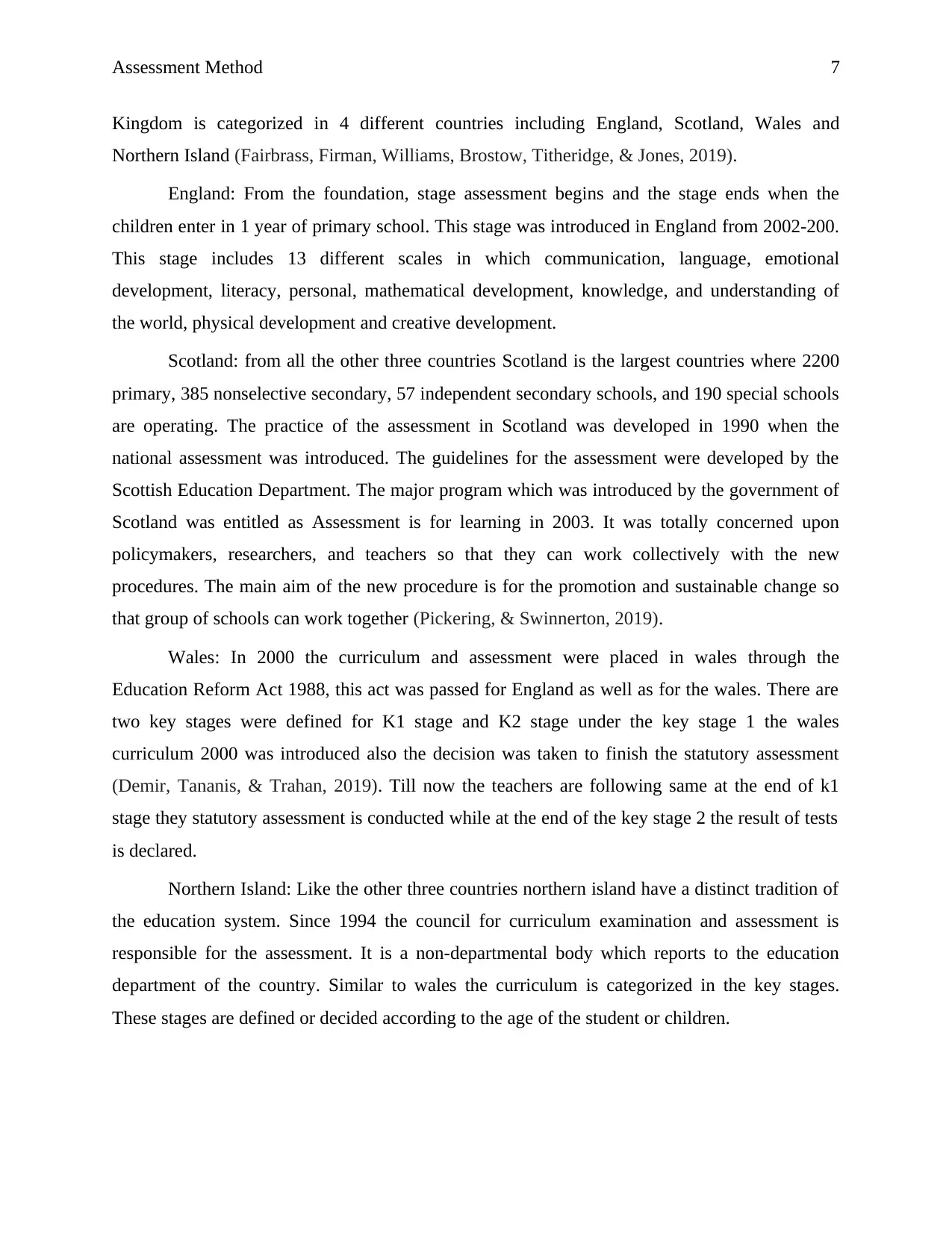
Assessment Method 7
Kingdom is categorized in 4 different countries including England, Scotland, Wales and
Northern Island (Fairbrass, Firman, Williams, Brostow, Titheridge, & Jones, 2019).
England: From the foundation, stage assessment begins and the stage ends when the
children enter in 1 year of primary school. This stage was introduced in England from 2002-200.
This stage includes 13 different scales in which communication, language, emotional
development, literacy, personal, mathematical development, knowledge, and understanding of
the world, physical development and creative development.
Scotland: from all the other three countries Scotland is the largest countries where 2200
primary, 385 nonselective secondary, 57 independent secondary schools, and 190 special schools
are operating. The practice of the assessment in Scotland was developed in 1990 when the
national assessment was introduced. The guidelines for the assessment were developed by the
Scottish Education Department. The major program which was introduced by the government of
Scotland was entitled as Assessment is for learning in 2003. It was totally concerned upon
policymakers, researchers, and teachers so that they can work collectively with the new
procedures. The main aim of the new procedure is for the promotion and sustainable change so
that group of schools can work together (Pickering, & Swinnerton, 2019).
Wales: In 2000 the curriculum and assessment were placed in wales through the
Education Reform Act 1988, this act was passed for England as well as for the wales. There are
two key stages were defined for K1 stage and K2 stage under the key stage 1 the wales
curriculum 2000 was introduced also the decision was taken to finish the statutory assessment
(Demir, Tananis, & Trahan, 2019). Till now the teachers are following same at the end of k1
stage they statutory assessment is conducted while at the end of the key stage 2 the result of tests
is declared.
Northern Island: Like the other three countries northern island have a distinct tradition of
the education system. Since 1994 the council for curriculum examination and assessment is
responsible for the assessment. It is a non-departmental body which reports to the education
department of the country. Similar to wales the curriculum is categorized in the key stages.
These stages are defined or decided according to the age of the student or children.
Kingdom is categorized in 4 different countries including England, Scotland, Wales and
Northern Island (Fairbrass, Firman, Williams, Brostow, Titheridge, & Jones, 2019).
England: From the foundation, stage assessment begins and the stage ends when the
children enter in 1 year of primary school. This stage was introduced in England from 2002-200.
This stage includes 13 different scales in which communication, language, emotional
development, literacy, personal, mathematical development, knowledge, and understanding of
the world, physical development and creative development.
Scotland: from all the other three countries Scotland is the largest countries where 2200
primary, 385 nonselective secondary, 57 independent secondary schools, and 190 special schools
are operating. The practice of the assessment in Scotland was developed in 1990 when the
national assessment was introduced. The guidelines for the assessment were developed by the
Scottish Education Department. The major program which was introduced by the government of
Scotland was entitled as Assessment is for learning in 2003. It was totally concerned upon
policymakers, researchers, and teachers so that they can work collectively with the new
procedures. The main aim of the new procedure is for the promotion and sustainable change so
that group of schools can work together (Pickering, & Swinnerton, 2019).
Wales: In 2000 the curriculum and assessment were placed in wales through the
Education Reform Act 1988, this act was passed for England as well as for the wales. There are
two key stages were defined for K1 stage and K2 stage under the key stage 1 the wales
curriculum 2000 was introduced also the decision was taken to finish the statutory assessment
(Demir, Tananis, & Trahan, 2019). Till now the teachers are following same at the end of k1
stage they statutory assessment is conducted while at the end of the key stage 2 the result of tests
is declared.
Northern Island: Like the other three countries northern island have a distinct tradition of
the education system. Since 1994 the council for curriculum examination and assessment is
responsible for the assessment. It is a non-departmental body which reports to the education
department of the country. Similar to wales the curriculum is categorized in the key stages.
These stages are defined or decided according to the age of the student or children.
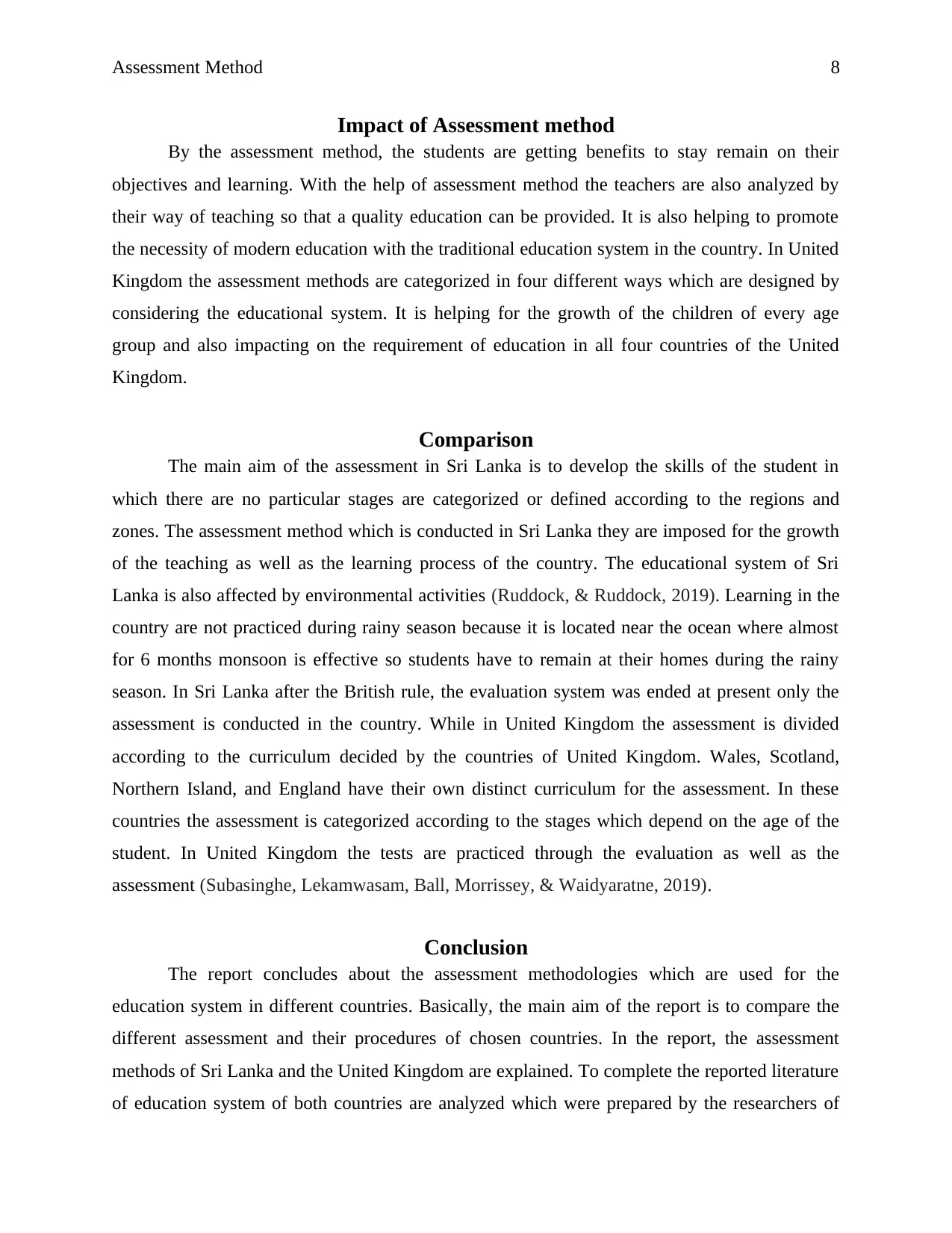
Assessment Method 8
Impact of Assessment method
By the assessment method, the students are getting benefits to stay remain on their
objectives and learning. With the help of assessment method the teachers are also analyzed by
their way of teaching so that a quality education can be provided. It is also helping to promote
the necessity of modern education with the traditional education system in the country. In United
Kingdom the assessment methods are categorized in four different ways which are designed by
considering the educational system. It is helping for the growth of the children of every age
group and also impacting on the requirement of education in all four countries of the United
Kingdom.
Comparison
The main aim of the assessment in Sri Lanka is to develop the skills of the student in
which there are no particular stages are categorized or defined according to the regions and
zones. The assessment method which is conducted in Sri Lanka they are imposed for the growth
of the teaching as well as the learning process of the country. The educational system of Sri
Lanka is also affected by environmental activities (Ruddock, & Ruddock, 2019). Learning in the
country are not practiced during rainy season because it is located near the ocean where almost
for 6 months monsoon is effective so students have to remain at their homes during the rainy
season. In Sri Lanka after the British rule, the evaluation system was ended at present only the
assessment is conducted in the country. While in United Kingdom the assessment is divided
according to the curriculum decided by the countries of United Kingdom. Wales, Scotland,
Northern Island, and England have their own distinct curriculum for the assessment. In these
countries the assessment is categorized according to the stages which depend on the age of the
student. In United Kingdom the tests are practiced through the evaluation as well as the
assessment (Subasinghe, Lekamwasam, Ball, Morrissey, & Waidyaratne, 2019).
Conclusion
The report concludes about the assessment methodologies which are used for the
education system in different countries. Basically, the main aim of the report is to compare the
different assessment and their procedures of chosen countries. In the report, the assessment
methods of Sri Lanka and the United Kingdom are explained. To complete the reported literature
of education system of both countries are analyzed which were prepared by the researchers of
Impact of Assessment method
By the assessment method, the students are getting benefits to stay remain on their
objectives and learning. With the help of assessment method the teachers are also analyzed by
their way of teaching so that a quality education can be provided. It is also helping to promote
the necessity of modern education with the traditional education system in the country. In United
Kingdom the assessment methods are categorized in four different ways which are designed by
considering the educational system. It is helping for the growth of the children of every age
group and also impacting on the requirement of education in all four countries of the United
Kingdom.
Comparison
The main aim of the assessment in Sri Lanka is to develop the skills of the student in
which there are no particular stages are categorized or defined according to the regions and
zones. The assessment method which is conducted in Sri Lanka they are imposed for the growth
of the teaching as well as the learning process of the country. The educational system of Sri
Lanka is also affected by environmental activities (Ruddock, & Ruddock, 2019). Learning in the
country are not practiced during rainy season because it is located near the ocean where almost
for 6 months monsoon is effective so students have to remain at their homes during the rainy
season. In Sri Lanka after the British rule, the evaluation system was ended at present only the
assessment is conducted in the country. While in United Kingdom the assessment is divided
according to the curriculum decided by the countries of United Kingdom. Wales, Scotland,
Northern Island, and England have their own distinct curriculum for the assessment. In these
countries the assessment is categorized according to the stages which depend on the age of the
student. In United Kingdom the tests are practiced through the evaluation as well as the
assessment (Subasinghe, Lekamwasam, Ball, Morrissey, & Waidyaratne, 2019).
Conclusion
The report concludes about the assessment methodologies which are used for the
education system in different countries. Basically, the main aim of the report is to compare the
different assessment and their procedures of chosen countries. In the report, the assessment
methods of Sri Lanka and the United Kingdom are explained. To complete the reported literature
of education system of both countries are analyzed which were prepared by the researchers of
⊘ This is a preview!⊘
Do you want full access?
Subscribe today to unlock all pages.

Trusted by 1+ million students worldwide
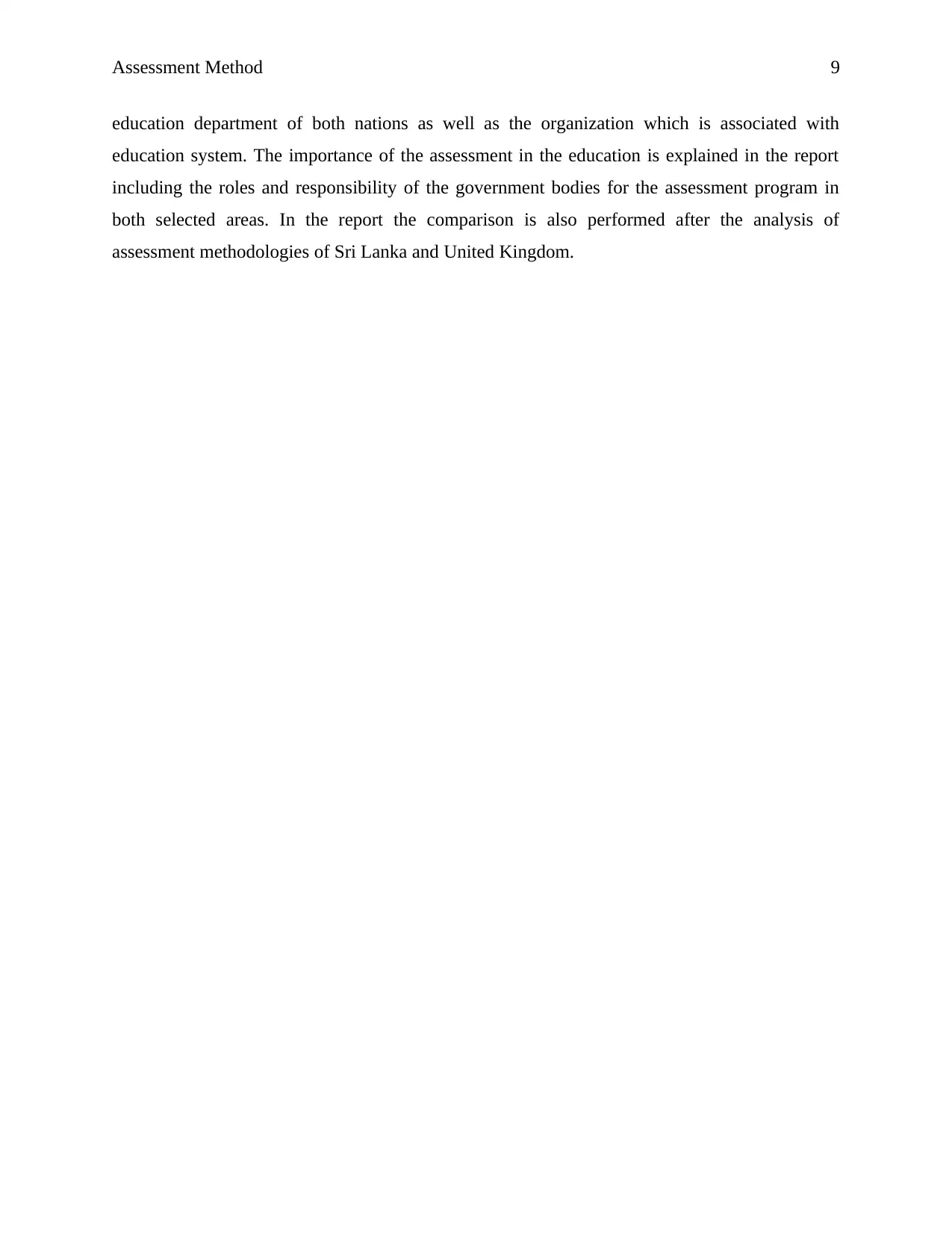
Assessment Method 9
education department of both nations as well as the organization which is associated with
education system. The importance of the assessment in the education is explained in the report
including the roles and responsibility of the government bodies for the assessment program in
both selected areas. In the report the comparison is also performed after the analysis of
assessment methodologies of Sri Lanka and United Kingdom.
education department of both nations as well as the organization which is associated with
education system. The importance of the assessment in the education is explained in the report
including the roles and responsibility of the government bodies for the assessment program in
both selected areas. In the report the comparison is also performed after the analysis of
assessment methodologies of Sri Lanka and United Kingdom.
Paraphrase This Document
Need a fresh take? Get an instant paraphrase of this document with our AI Paraphraser
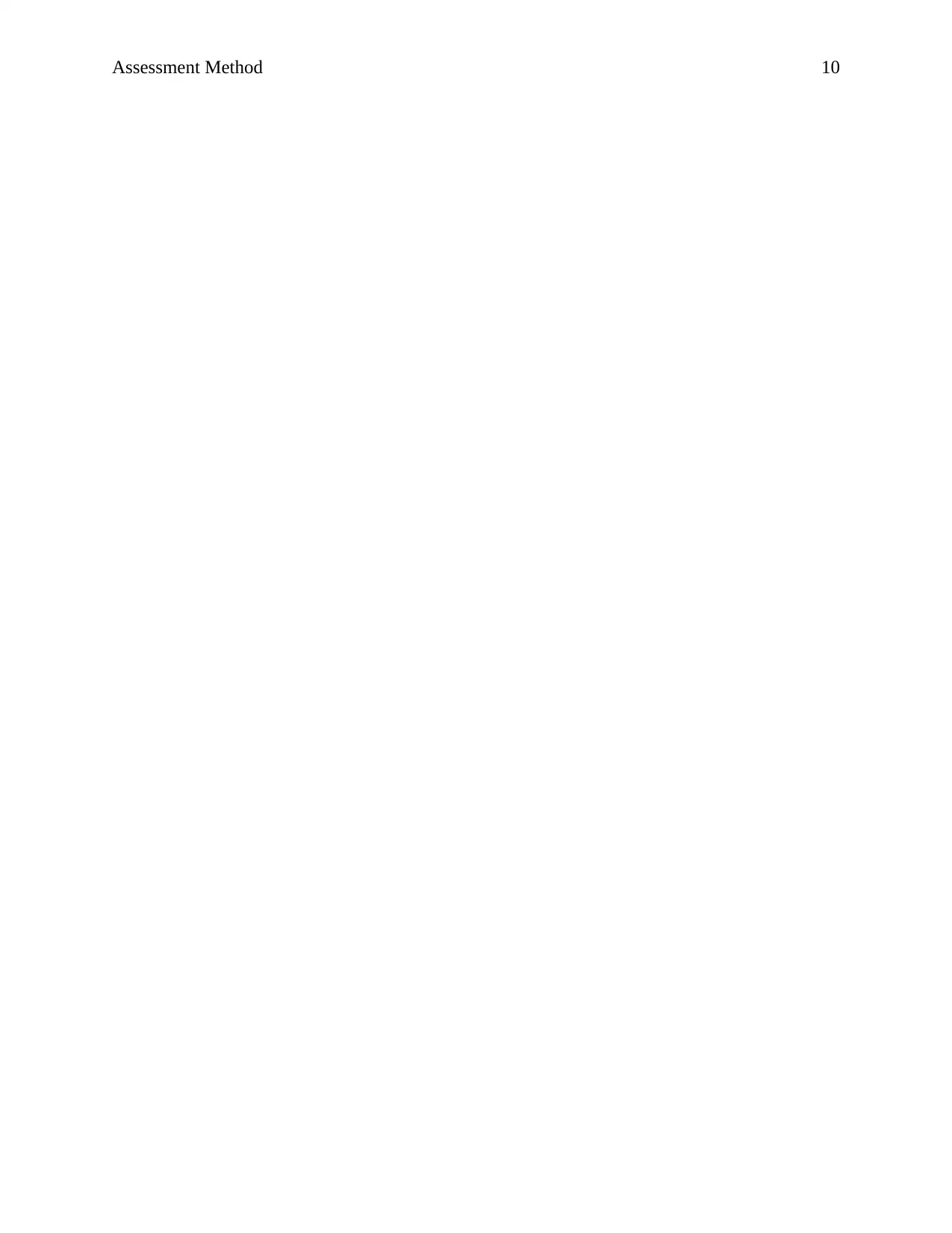
Assessment Method 10
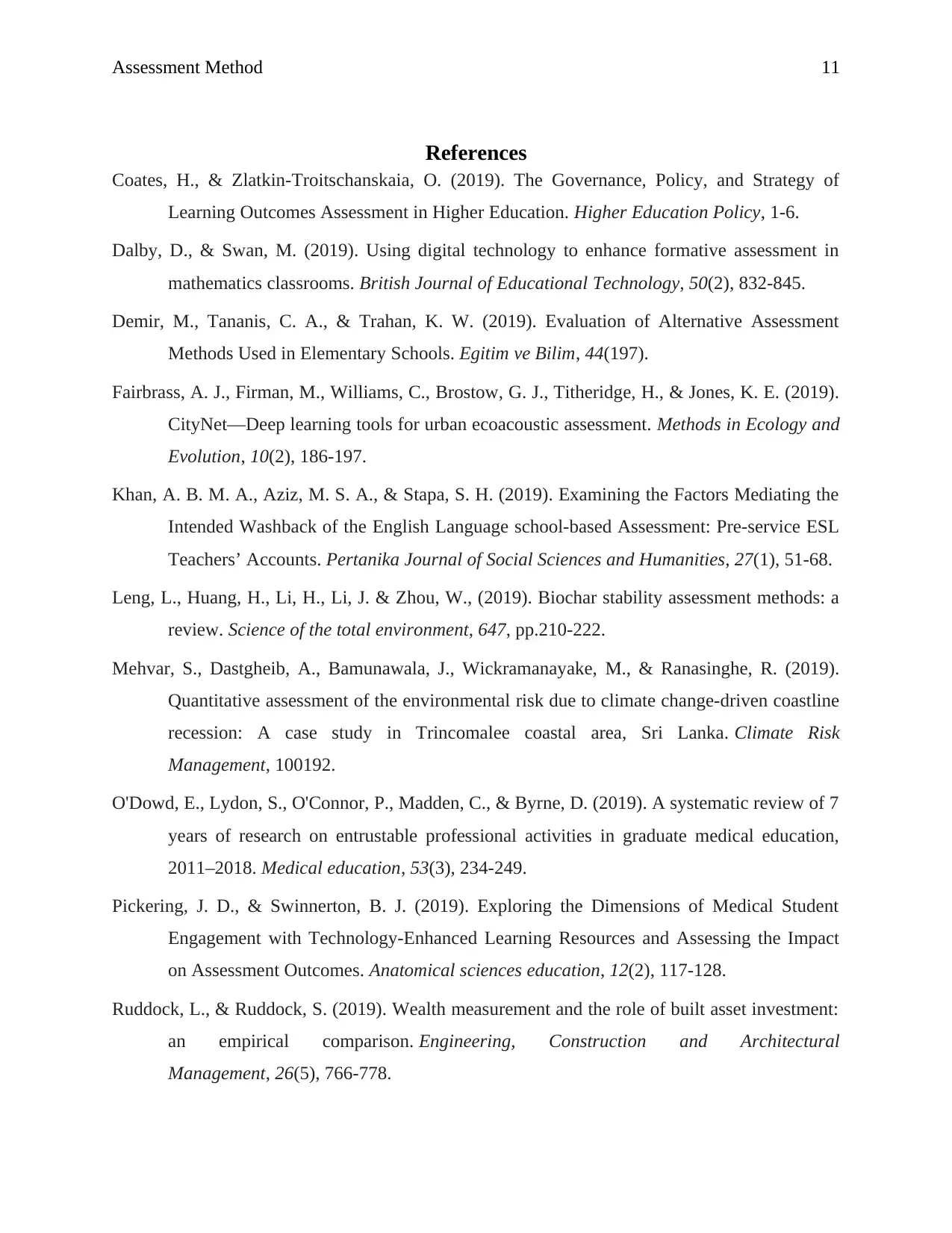
Assessment Method 11
References
Coates, H., & Zlatkin-Troitschanskaia, O. (2019). The Governance, Policy, and Strategy of
Learning Outcomes Assessment in Higher Education. Higher Education Policy, 1-6.
Dalby, D., & Swan, M. (2019). Using digital technology to enhance formative assessment in
mathematics classrooms. British Journal of Educational Technology, 50(2), 832-845.
Demir, M., Tananis, C. A., & Trahan, K. W. (2019). Evaluation of Alternative Assessment
Methods Used in Elementary Schools. Egitim ve Bilim, 44(197).
Fairbrass, A. J., Firman, M., Williams, C., Brostow, G. J., Titheridge, H., & Jones, K. E. (2019).
CityNet—Deep learning tools for urban ecoacoustic assessment. Methods in Ecology and
Evolution, 10(2), 186-197.
Khan, A. B. M. A., Aziz, M. S. A., & Stapa, S. H. (2019). Examining the Factors Mediating the
Intended Washback of the English Language school-based Assessment: Pre-service ESL
Teachers’ Accounts. Pertanika Journal of Social Sciences and Humanities, 27(1), 51-68.
Leng, L., Huang, H., Li, H., Li, J. & Zhou, W., (2019). Biochar stability assessment methods: a
review. Science of the total environment, 647, pp.210-222.
Mehvar, S., Dastgheib, A., Bamunawala, J., Wickramanayake, M., & Ranasinghe, R. (2019).
Quantitative assessment of the environmental risk due to climate change-driven coastline
recession: A case study in Trincomalee coastal area, Sri Lanka. Climate Risk
Management, 100192.
O'Dowd, E., Lydon, S., O'Connor, P., Madden, C., & Byrne, D. (2019). A systematic review of 7
years of research on entrustable professional activities in graduate medical education,
2011–2018. Medical education, 53(3), 234-249.
Pickering, J. D., & Swinnerton, B. J. (2019). Exploring the Dimensions of Medical Student
Engagement with Technology‐Enhanced Learning Resources and Assessing the Impact
on Assessment Outcomes. Anatomical sciences education, 12(2), 117-128.
Ruddock, L., & Ruddock, S. (2019). Wealth measurement and the role of built asset investment:
an empirical comparison. Engineering, Construction and Architectural
Management, 26(5), 766-778.
References
Coates, H., & Zlatkin-Troitschanskaia, O. (2019). The Governance, Policy, and Strategy of
Learning Outcomes Assessment in Higher Education. Higher Education Policy, 1-6.
Dalby, D., & Swan, M. (2019). Using digital technology to enhance formative assessment in
mathematics classrooms. British Journal of Educational Technology, 50(2), 832-845.
Demir, M., Tananis, C. A., & Trahan, K. W. (2019). Evaluation of Alternative Assessment
Methods Used in Elementary Schools. Egitim ve Bilim, 44(197).
Fairbrass, A. J., Firman, M., Williams, C., Brostow, G. J., Titheridge, H., & Jones, K. E. (2019).
CityNet—Deep learning tools for urban ecoacoustic assessment. Methods in Ecology and
Evolution, 10(2), 186-197.
Khan, A. B. M. A., Aziz, M. S. A., & Stapa, S. H. (2019). Examining the Factors Mediating the
Intended Washback of the English Language school-based Assessment: Pre-service ESL
Teachers’ Accounts. Pertanika Journal of Social Sciences and Humanities, 27(1), 51-68.
Leng, L., Huang, H., Li, H., Li, J. & Zhou, W., (2019). Biochar stability assessment methods: a
review. Science of the total environment, 647, pp.210-222.
Mehvar, S., Dastgheib, A., Bamunawala, J., Wickramanayake, M., & Ranasinghe, R. (2019).
Quantitative assessment of the environmental risk due to climate change-driven coastline
recession: A case study in Trincomalee coastal area, Sri Lanka. Climate Risk
Management, 100192.
O'Dowd, E., Lydon, S., O'Connor, P., Madden, C., & Byrne, D. (2019). A systematic review of 7
years of research on entrustable professional activities in graduate medical education,
2011–2018. Medical education, 53(3), 234-249.
Pickering, J. D., & Swinnerton, B. J. (2019). Exploring the Dimensions of Medical Student
Engagement with Technology‐Enhanced Learning Resources and Assessing the Impact
on Assessment Outcomes. Anatomical sciences education, 12(2), 117-128.
Ruddock, L., & Ruddock, S. (2019). Wealth measurement and the role of built asset investment:
an empirical comparison. Engineering, Construction and Architectural
Management, 26(5), 766-778.
⊘ This is a preview!⊘
Do you want full access?
Subscribe today to unlock all pages.

Trusted by 1+ million students worldwide
1 out of 13
Related Documents
Your All-in-One AI-Powered Toolkit for Academic Success.
+13062052269
info@desklib.com
Available 24*7 on WhatsApp / Email
![[object Object]](/_next/static/media/star-bottom.7253800d.svg)
Unlock your academic potential
Copyright © 2020–2025 A2Z Services. All Rights Reserved. Developed and managed by ZUCOL.




